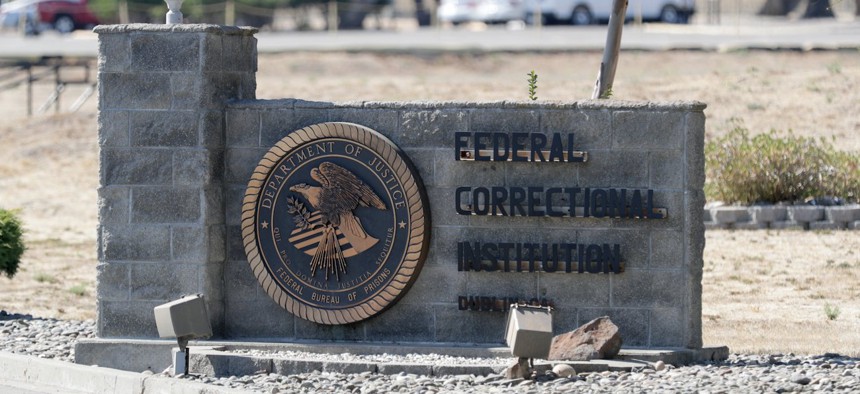
The Dublin Federal Correctional Institution in Dublin, Calif. Anda Chu/MediaNews Group/The Mercury News via Getty Images
Bureau of Prisons employees welcome their raise, unions embrace the shutdown pause, and OPM urges an early start on Open Season
Pay and benefits updates you may have missed.
The Bureau of Prisons is burdened by a long list of unresolved problems that hamper employees at work—and, with low compensation on that list, also at home.
But now at least the pay piece of the agency’s many troubles is about to improve: The White House has authorized 25% retention bonuses at eight BOP facilities.
“Thanks to this action by the Biden administration, these prisons will be better equipped to retain their hard-working employees and recruit new officers and staff to help address persistent understaffing,” said Everett Kelley, president of the American Federation of Government Employees.
The union characterizes the current understaffing at many facilities as “dangerous.” It cites a huge shortage of officers—reportedly 40% below targets, a situation that has worsened rather than improved in recent years.
AFGE’s Council of Prison Locals has been pressing for additional pay, arguing it is a crucial tool to reduce employee attrition and boost recruiting.
“Our correctional officers and support staff are overworked, underpaid, and putting themselves in harms’ way every time they go to work.” Brandy Moore White, the president of AFGE Council 33, said. “These retention bonuses will encourage more of our employees to stay on the job and will help the agency’s recruitment efforts.”
Shutdown averted, for now
Since Sept. 30, when a fractured Congress barely managed to pass a 45-day continuing resolution, federal employees and contractors have been doing what they always do: Going to work, getting the job done—along with feeling a little more secure about making mortgage and car payments. The much-feared shutdown—with its possible delays in pay—remains, for now anyway, a mere possibility.
Fed unions and other employee organizations expressed relief—tinged with concern as to whether lawmakers can get it together to pass more enduring funding by the new Nov. 17 shutdown deadline.
“As I’ve said many times in recent days, I’ve always remained hopeful that a bipartisan deal to avoid a government shutdown was possible, however unlikely it seemed at times,” AFGE’s Kelley said just after Congress acted to avoid the lapse. “The costs to federal employees, to the economy, to our communities, and to the American people are simply too great.”
“We can breathe a sigh of relief—for now,” declared Lee Saunders, president of the American Federation of State, County and Municipal Employees, which also represents thousands of feds.
“Federal employees across the country are relieved that Congress was able to reach a bipartisan agreement to fund our government and avert a shutdown,” said National Federation of Federal Employees President Randy Erwin, noting that “approximately 1.5 million federal employees who were set to lose their pay can sleep easy knowing their income is not going to be cut off because Congress could not do its job.”
That’s that. Or is it? Since the CR was passed, Rep. Kevin McCarthy, R-Calif., was voted out as Speaker, prompted by an historically unprecedented vote initiated by members of his own party. Anxiety is building again—not just on pay and benefits but just about everything else about federal government. Just over a month remains before the new deadline. Stay tuned.
OPM on Open Season: Start early
So, mid-November will see the new deadline for lawmakers to fund the government—including salaries and benefits for its employees. It will also bring the launch of Open Season, the period each year when feds get to pick and choose options available under their key benefits—health insurance, as well as dental and eyecare coverage.
Office of Personnel Management Director Kiran Ahuja is reminding feds to get on with their own rational financial planning early (even if Congress is dealing with the bigger picture rather late).
“Federal employees and annuitants should take advantage of Open Season to conduct a wellness and financial check-up for their health care coverage to ensure they are getting the most from their benefits,” Ahuja announced, urging feds to get ready for the period. “From our data, less than 5 percent of federal enrollees change their health plans during Federal Benefits Open Season, which means our workforce could be leaving behind valuable savings.”
With federal health insurance premiums currently set to rise an average of 7.7% in the coming year, Ahuja’s message is an important one: Start now and take some time to study your coverage options, to optimize your costs. OPM’s release underscores the director’s call that more feds should take advantage of this time to “reassess their health, dental, and vision coverage and ensure their plans are cost-efficient and address the care enrollees and their families need.”
The same OPM document offers a brief overview of the Federal Employees Health Benefits Program, the Federal Employees Dental and Vision Insurance Program, Federal Flexible Spending Account Program—as well as links to pages with details on up-to-date news and information on the programs.






